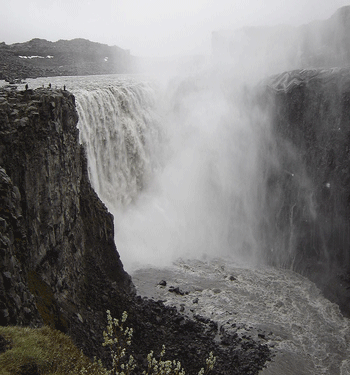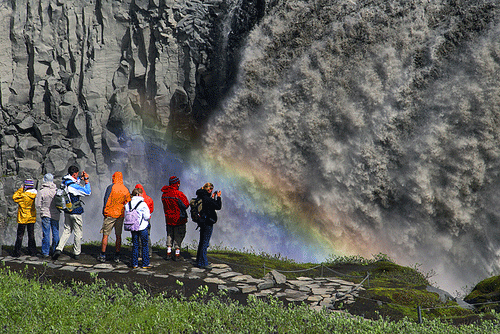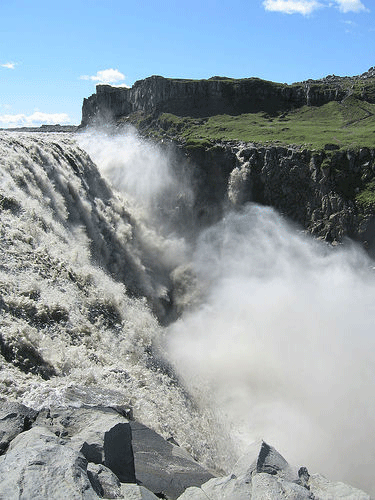|
To
the waterfall "Dettifoss" is a short walk from the car park in the "National Park of
Jokulsargljufur". You go across "Sandadalur", a small valley
containing an old river bed that bears witness to the power of the
"Jokulsa a Fjollum" river and the "jokulhlaups" (flood) that thunder down it from
time to time. Since it’s partly buried in the canyon,
Dettifoss is overlooked by
cliffs on both sides. From the west, the full face of the waterfall can
be seen, and a short walk, places you on top of the lava dam and
fault line, that are responsible for the waterfall’s location.
The waterfall is heard well before it is seen and the spray can
be seen over ridges, before the edge of the canyon is reached. This
isn't surprising. Dettifoss is Europe's greatest waterfall - at
least in terms of volume, which averages 500 cubic meters of water per
second during normal river conditions. Its volume often
increases, though, especially when the weather or volcanic activity
prompts glacial melting on (or under) the "Vatnajokull" glacier icecap. The
river water is almost always dark with sediment, in contrast with the
white rapids and spray and during floods the river and the falls are
often virtually black with sediment and debris.
As with other Icelandic waterfalls, Dettifoss is approached at your own risk. There are no safety barriers, although one or two paths have been roped off in order to control erosion damage caused by visitors. If you’re going near the waterfall, you’ll almost certainly need some sort of rain gear - the heavy spray that rains down on the surrounding area can quickly soak you. You’ll also need to restrain any impulses you may feel to jump into the falls. Standing close to all the roaring water can be hypnotic, and a ride over the edge probably isn’t survivable. |
 |
 |
 |
Dettifoss
is Europe’s mightiest waterfall. It is located in the "Mvatn"
area of
northeastern Iceland. It is situated on the "Jokulsa a Fjollum" river,
which flows from the "Vatnajokull" glacier and collects water from a
large area in north-east Iceland. It
is reputed to be the most powerful waterfall in Europe, having a flow
variously estimated at between 200 and 500 cubic meters of water per
second, depending on the season and the summer ice melt. The falls are
100 m wide and have a drop of 44 m down to the
Jokulsargljufur canyon. |

